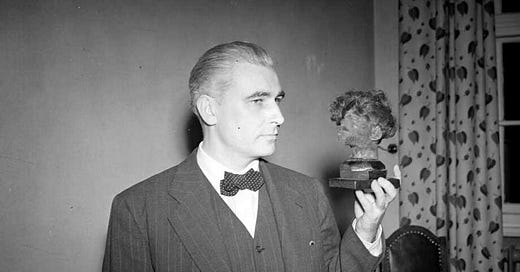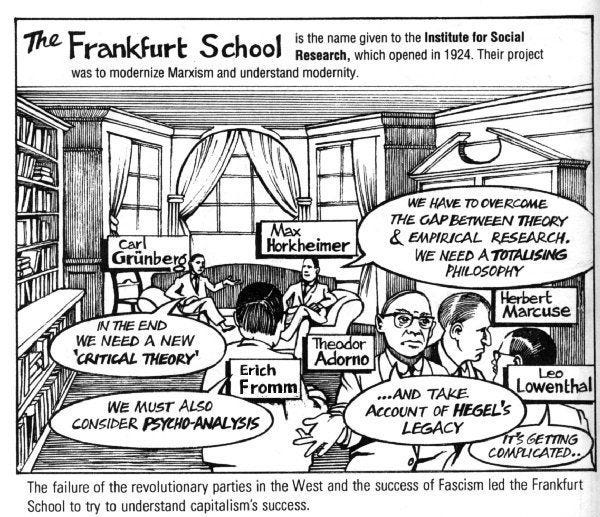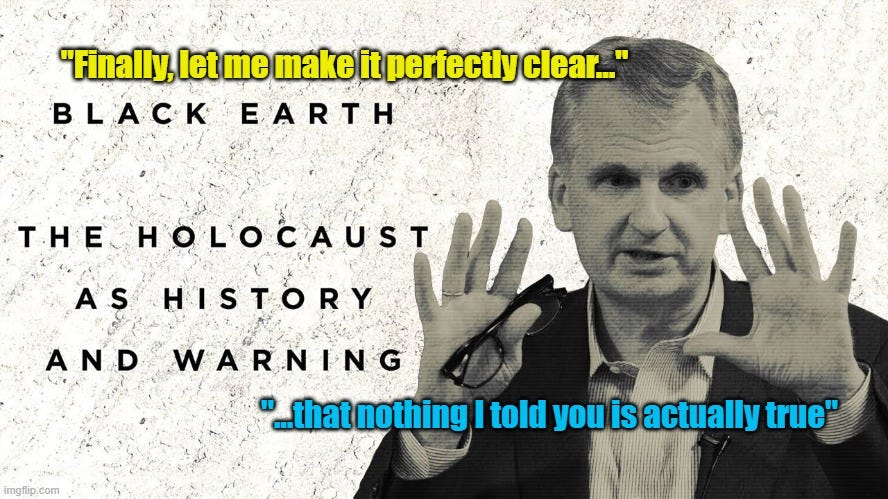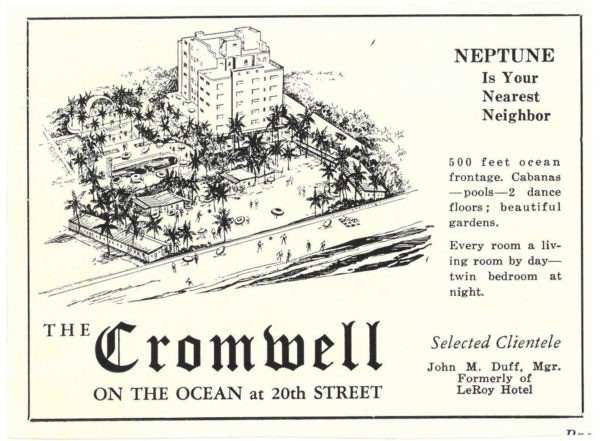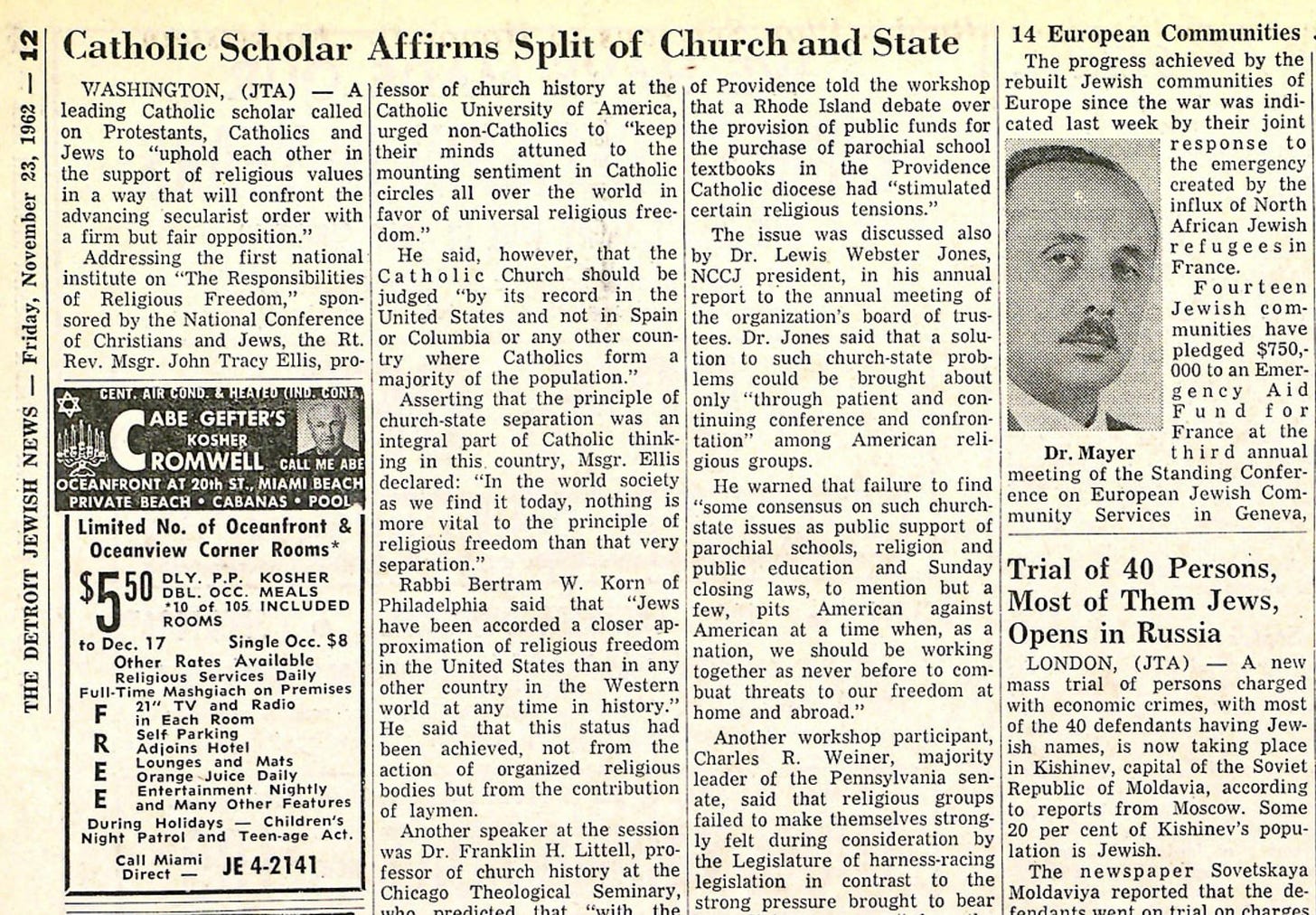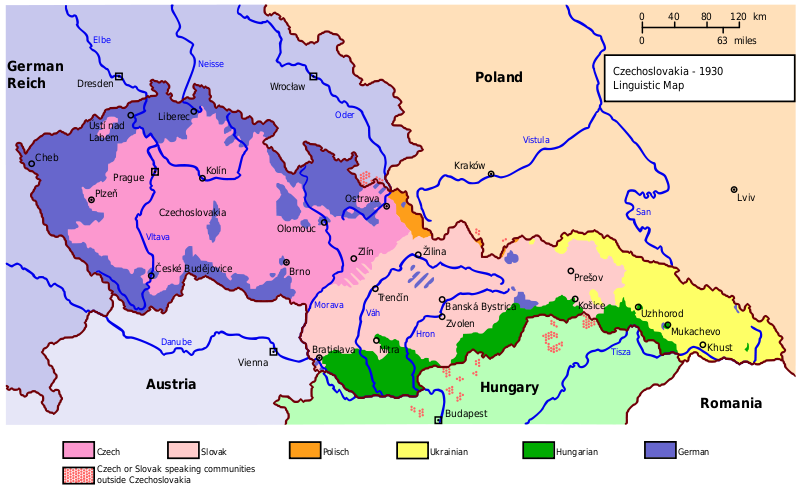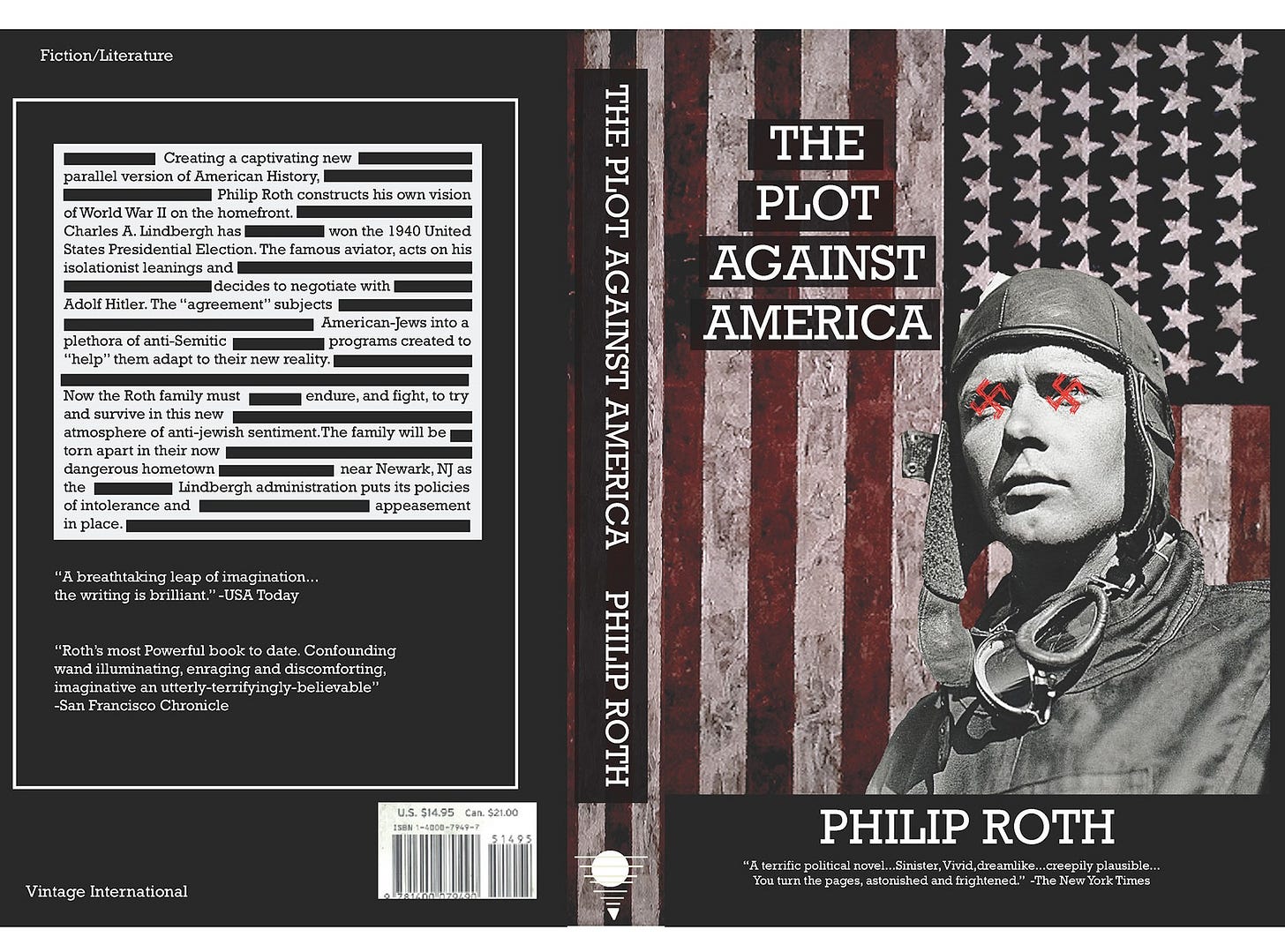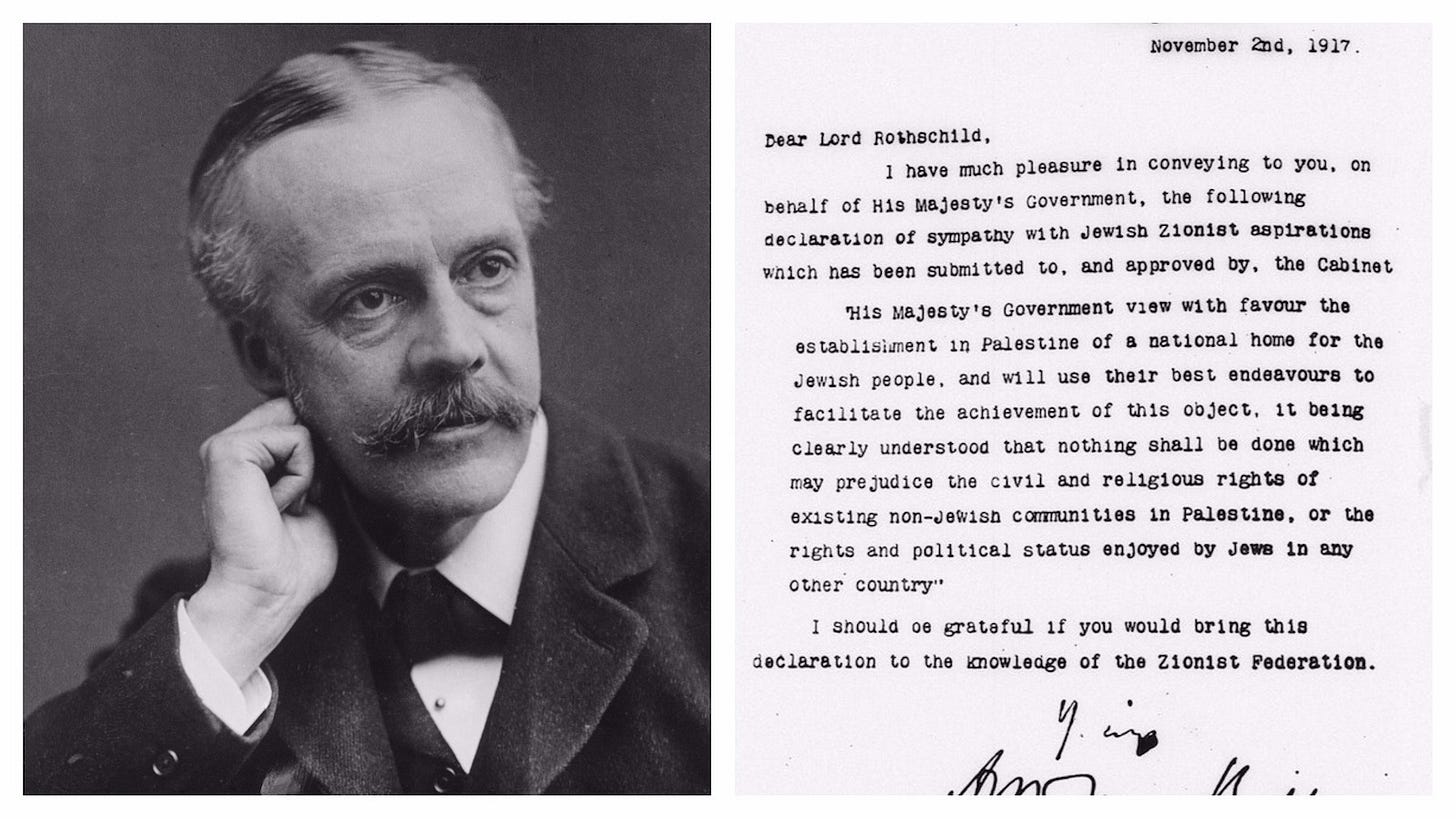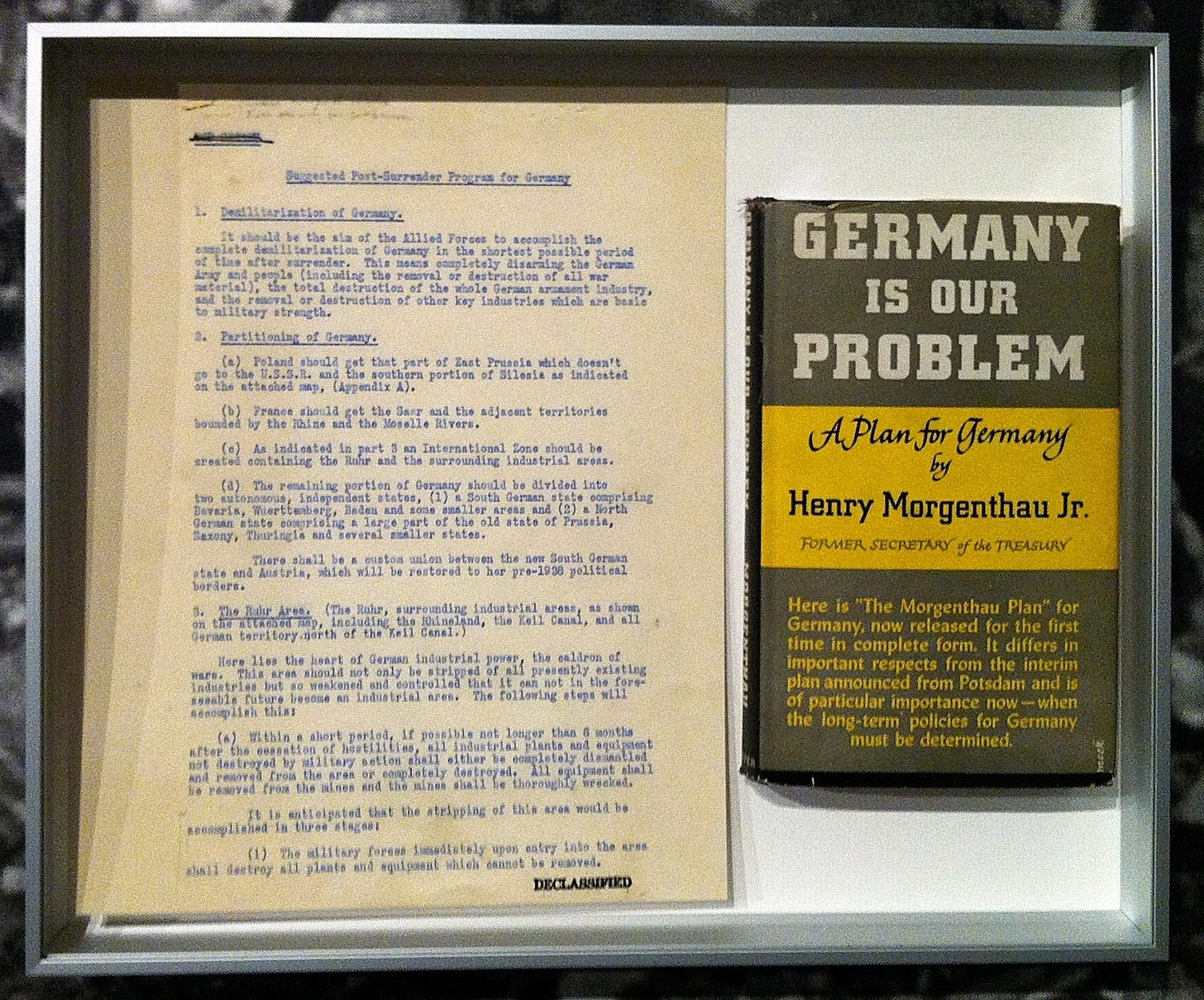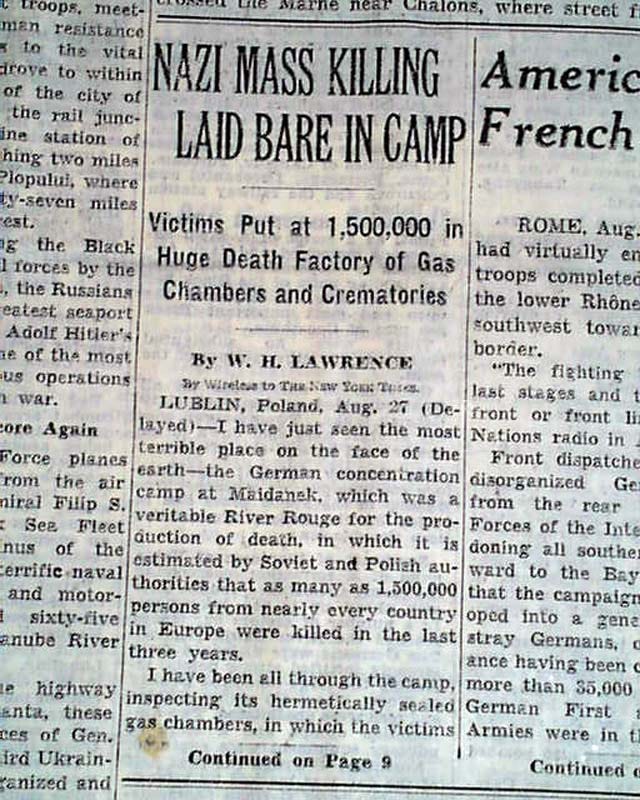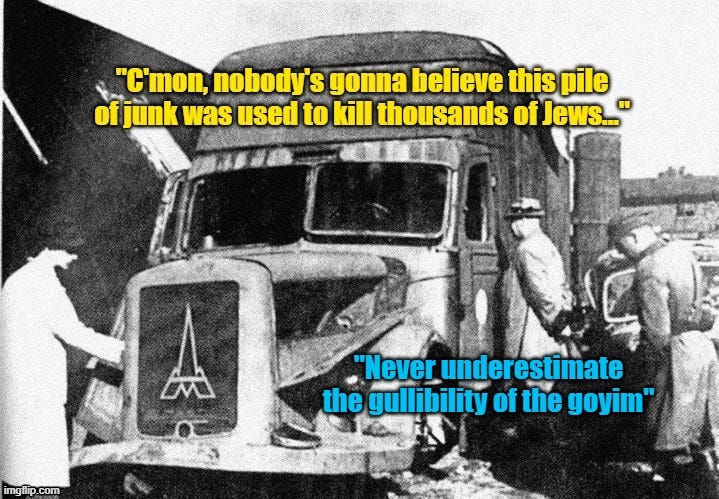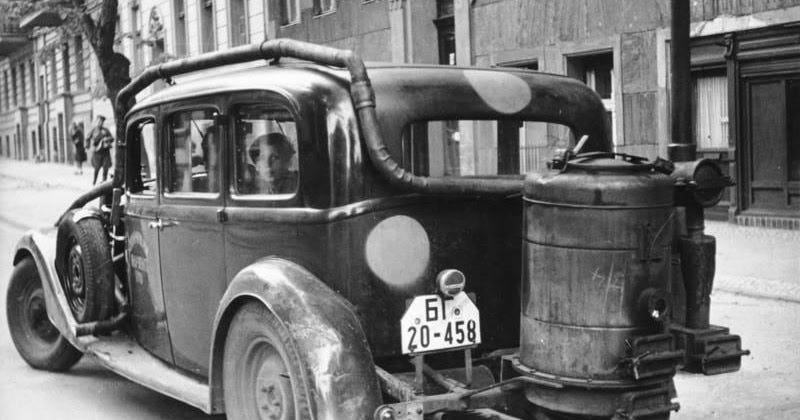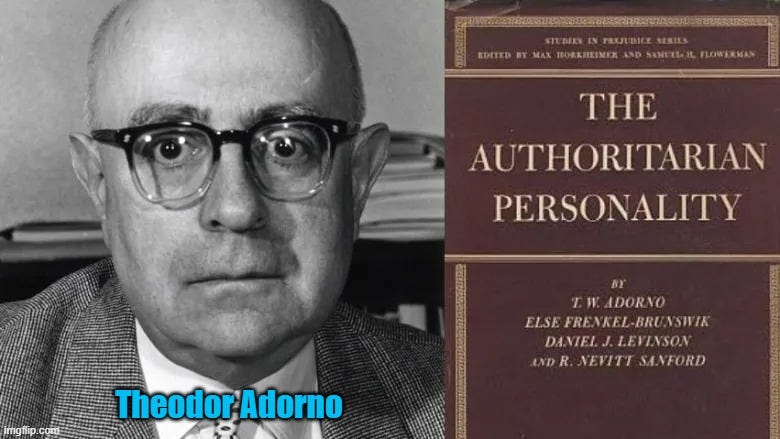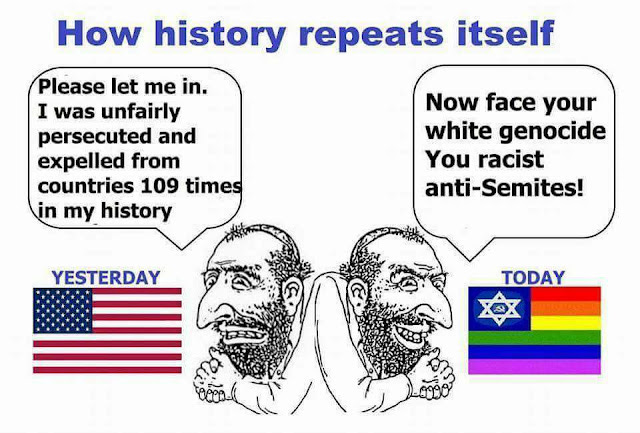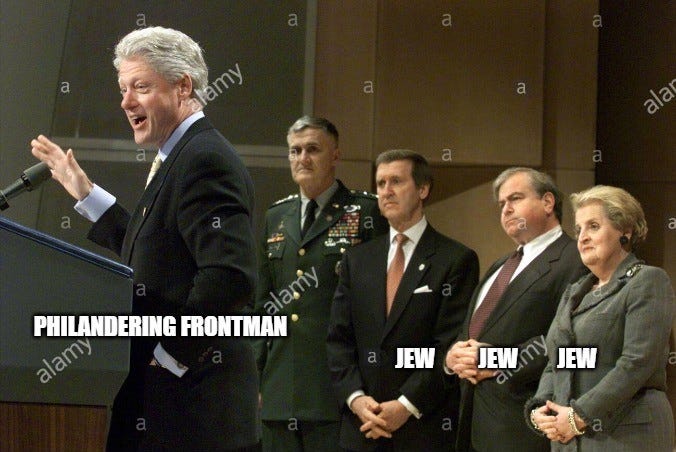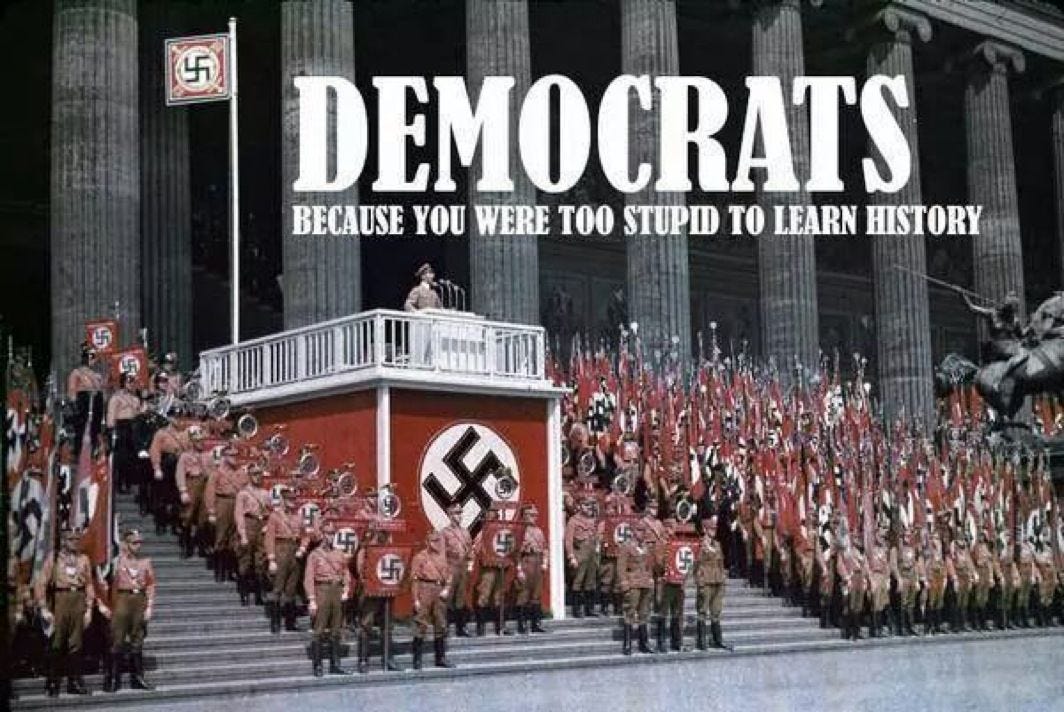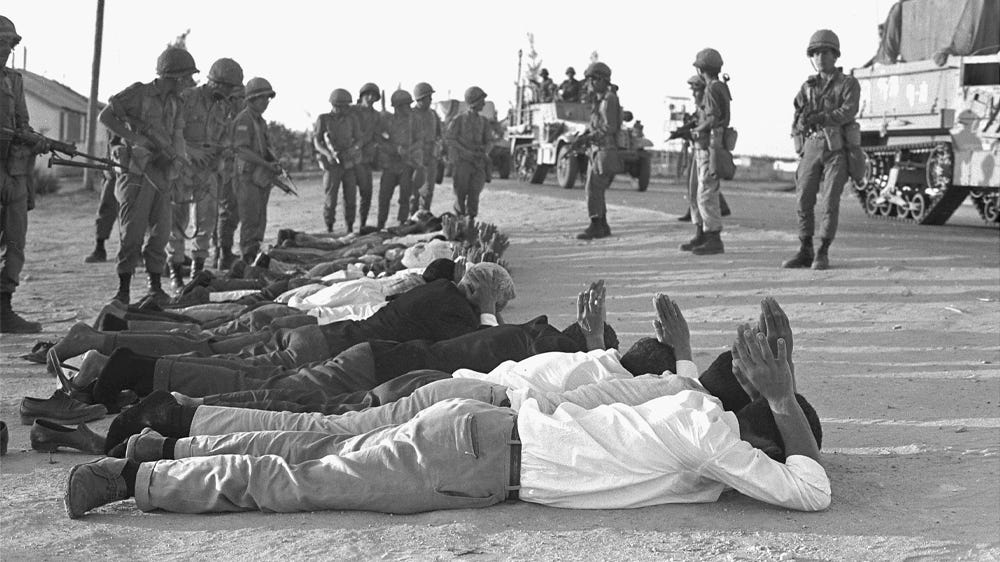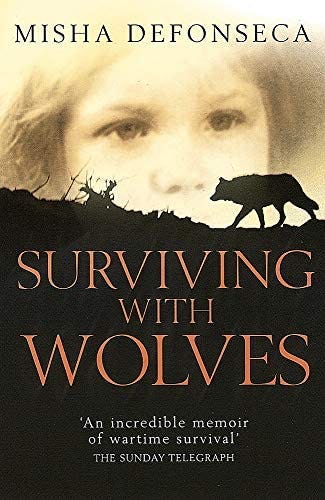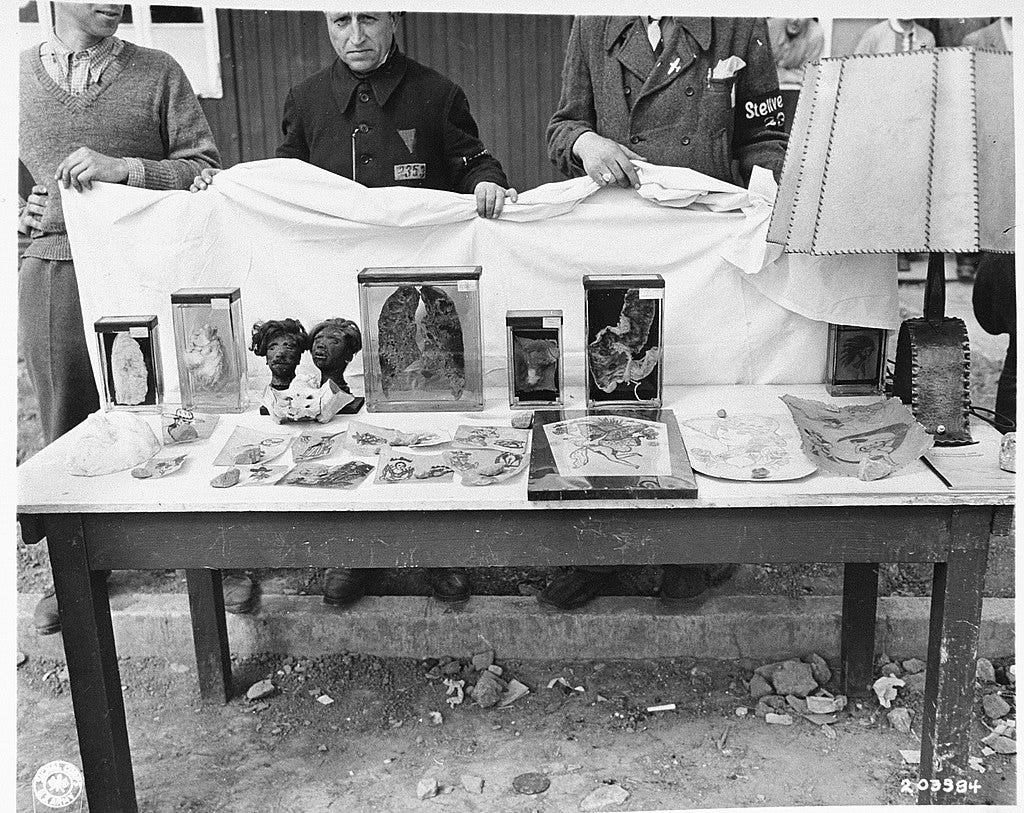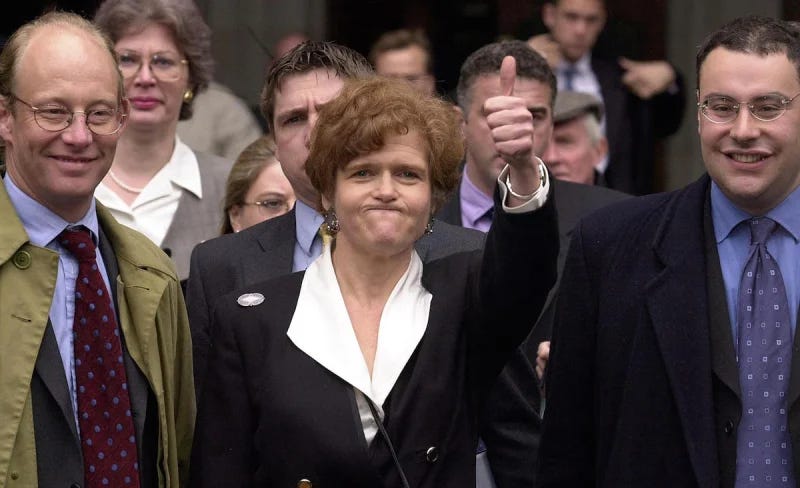And the Oscar winner for the Best Propaganda Documentary of 2022…
...is the PBS film The U.S. And The Holocaust, by Ken Burnstein, Lynn Novickowitz and Sarah Botsteinberg! Let’s give ‘em a big hand!
I was reminded a couple weeks ago that the latest PBS Ken Burns instant-classic documentary film had aired, which is generally about the Holocaust but specifically about the American role in that. I didn’t need to know any more than that to know what this would be like, because it was sure to follow the line of continuity that goes back to the birth of Holocaustism in 1961, and so I hunted it down online and watched it in detail, and in fact I have done a long series of videos (13 and counting) of various aspects of the work. And my conclusion is what I thought it was going to be before I watched it, that it is the propaganda event of the year, the most important mass media piece in terms of support of the establishment’s control over the populace and of its current agenda.
First, Holocaustism. I have defined that as the almost-religious belief in the murderous antisemitism of the gentile. This is in some sense the fourth stage of the evolution of Judaism, the first three being (pre-Christian) Torahism, Talmudism (which was significantly a reaction to the revolutionary loss to Rome, the diaspora and the rise of Christianity in the west) and Zionism (the first step of secularization of Judaism and the first stage of proselytizing of their beliefs to the gentiles). While Zionism has at least to some degree been accepted by the vast majority of Jews and, at least in America, a very large percentage of non-Jews, Holocaustism is accepted by virtually every Jew and the vast majority of non-Jews. It’s not really an overstatement to say Holocaustism is the faith of America today.
I say it all started in 1961, and that’s due to three events during that year. The year dawned with Otto Preminger’s epic film Exodus in the theaters, an adaptation of a popular novel by Leon Uris about the birth of Israel, and Jewish Hollywood followed that with Stanley Kramer’s star-studded film Judgment at Nuremberg. It was the year that Adolph Eichmann was kidnapped in Argentina by the Mossad, brought to Israel to put on a show trial and ultimately subjected to capital punishment. It was also the year that Raul Hilberg’s seminal work on the Holocaust, The Destruction of the European Jews, was published. My understanding is that before this what became the Holocaust wasn’t much discussed outside of the Jewish community (and perhaps inside that as well), in essence just another horrible aspect of a horrible war.
But it hasn’t been that since then, and that change over the last 60 years has been continuously evolving. As well as the constant growth in the vast library of survivor memoirs, Hollywood continued to do their part in the ‘70s and ‘80s, and by the end of that decade the reaction had began, the birth of revisionism or “Holocaust denial”, which hit its visible peak in the early ‘90s. But then came the counter-reaction, most visibly in the person of Hollywood oligarch Steven Spielberg, who made his epic Holocaust film Schindler’s List in 1993 and then followed that with his version of the Holocaust documentary film, The Last Days, in 1998, built on his Shoah project. That era closed with the Lipstadt-Irving trial in the UK in 2000 (later “documented” by Hollywood in the film Denial). 2000 also was of course the year that George W. Bush was “elected” and then turned US foreign policy over to the cabal of neocons escorted into the administration by VP Cheney and Sec of Defense Rumsfeld. This era also featured the criminalization of speech - the vast majority of hate speech and holocaust denial laws in Europe and elsewhere were written in the last 25 years.
More recently we have seen the narrative of a rise in antisemitism emerging, tied to Trumpism but not only, and that has included the birth of the concept of a third version of antisemitism joining Arab/Muslim antisemitism (part of the middle east war narrative) and right-wing antisemitism (the white nationalism/supremacy/neo-nazi narrative). And that version is left-wing antisemitism, which arose out of the British Labour Party, Jeremy Corbyn and their lack of support for the middle east wars and their criticism of Israel for their treatment of the Palestinians. An example of this is in Bari Weiss’ 2019 book How to Fight Anti-Semitism; Weiss is a neocon journalist, attended the Tree of Life synagogue in Pittsburgh as a child, went to Columbia and Hebrew University of Jerusalem, was a protege of fellow neocon (Jewish) journalist Bret Stevens (see below on eugenics) at the Wall Street Journal and the New York Times, and now has a podcast called Honestly, its presentations I would guess being done anything but.
Her defining “toady” moment was on Joe Rogan’s podcast in 2019 when they were discussing Democratic nomination candidates and Rogan mentioned Tulsi Gabbard, and her immediate gut reaction was, “monstrous!”, to which she quickly added “ideas”. And what were those monstrous ideas? Opposition to the neoconservative agenda of regime-change wars in Israel’s neighborhood and the revving up of a new cold war with hated mother Russia. Left-wing antisemitism appears intended to specifically keep the left in line, given the nature of Dem left politics today - the embrace of neoconservatism and neoliberalism, etc.
Another recent signpost on the evolution of Holocaustism was the 2015 book Black Earth by Yale professor Timothy Snyder. This was sort of the sequel to his Bloodlands, which was about the real European war in the east between Germany and the USSR and which made his bones as a popular historian. Black Earth focuses on the Einsatsgruppen killings in the east, utilizing firing squads and gas vans, and the title refers to Hitler’s lebensraum and the rich soils of Ukraine. The book does not break historical ground, rather echoes the evolved conventional history of events and leaves that completely unchallenged. What it does do is effectively move the narrative eastward, out of the death camps in Poland (considered most problematic by the revisionsists) and into the anarchy of the wilds of the German-occupied USSR, where almost nothing can really be proven (or disproven).
The academic theme of the book is about the vulnerability of “stateless” Jews, Jews having lost the protection of established state structures when those were destroyed by the Germans as it expanded during the war. That left the Jews vulnerable to everyone and not just the Nazis, although Snyder focused on local collaborators in organized killing more than general revenge killings and the like.
The most surprising aspect of the book to me probably was that in his concluding chapter he actually (but briefly) discussed as post-war issues on the right and the left, the “Vienna” School (Austrian School free-market capitalist economics, closely related to the Chicago School’s neoliberalism) which is a foundational piece of American anarcho-libertarianism today, and the Frankfurt School, which one can describe as the primary source of “cultural Marxism” (basically New Leftism) in the US in the ‘50s, ‘60s and ‘70s. Both of these academic movements were driven by Jews, the Frankfurt School exclusively Jews, but of course that is not detailed.
I have to also mention that Snyder’s wife is Jewish (making their children Jewish according to Jewish tradition) and is a fellow Yale history professor (in areas of Jewish concern), he is a member of the Committee on Conscience of the United States Holocaust Memorial Museum and also the Council on Foreign Relations, and I have read that his non-academic work has been significantly funded by the “Russian” (Jewish) oligarch Mikhail Khodorkovsky, one of the semibankirshchina of the late ‘90s, the biggest domestic enemy of Putin 20 years ago and then the richest person in the world under the age of 40. Since 2016, the election of Trump and the rise of Russiagate, he has written two books attacking the twin New Hitlers, On Tyranny: Twenty Lessons from the Twentieth Century and The Road to Unfreedom: Russia, Europe, America. So I was not at all surprised to see Snyder appear in this film, even though his area of Holocaust focus is about as far away from the area of focus of the film as one can get, geographically-speaking.
Which gets me to the film. The basic story starts with the immigration wave which occurred during the 50 years between the Civil War and World War One, that largely sourced from southern and eastern Europe, which meant Catholics and Jews. That resulted in the first broad immigration-limiting laws in US history, focused here on the 1924 Johnson-Reed Act (the 1921 emergency act not mentioned), limiting annual immigration from the eastern hemisphere by country of origin to a percentage (2%) of the preexisting US population from that country (as sourced from the 1890 census originally). The film mentions the prohibition on any immigration from east Asia as well. The lack of limits on Latin American immigration was explained away by saying these folks were needed as farm labor, which raised my eyebrows given the era in discussion – think Grapes of Wrath.
The table-setter for this was the genocide of American indians in the 19th century and the first immigration-limiting law applied to the Chinese in the 1880s, related to issues in California. Voices in this discussion beyond various Jewish historians utilized (including the star of the show, the Bulldog of Holocaustism and our country’s Special Envoy for Monitoring and Combating Anti-Semitism, Deborah Lipstadt) were two female historians, one black (Nell Irvin Painter) and the other Chinese-American (Mae Ngai), and they all were talking about what “we” had done, when it was becoming obvious that they were talking about what THEY had done, “they” being Euro-Christian Americans.
It was in the immigration law section that I noticed one of the first significant omissions in the film, the revision in 1929 of the law amending the census used to calculate the limits from 1890 to 1920 – given the numbers during that 30 years of the wave, a major increase in the limits; the real wave of Jewish emigration out of eastern Europe started after the assassination of Tsar Alexander II in 1881.
The second appetizer in the film was the “pseudo-science” of eugenics. Not really a surprise to me given that I had done a series of videos on eugenics only a couple months ago, including related to two books, Adam Cohen’s Imbeciles: The Supreme Court, American Eugenics, and the Sterilization of Carrie Buck published in 2016 and Robert F. Kennedy’s alt-book on Fauci published last year. Cohen is a Jew of course, and has an “intensely Jewish” background and activism which I won’t detail here, but my videos featured his appearance on Amy Goodman’s “Ashkenocracy Now” promoting the book. And Kennedy is Catholic, of course.
It’s in this section that the film first specifies Protestants as the real problem, the WASP elite, I suppose in part because Catholics were the biggest “victim group” related to the immigration law. At this point the film has established that WASPs are antisemites and racists, essentially, THE antisemites and racists. It also declares that “race itself is a fiction” – not by one of the film’s academic experts but by the film’s narration. Given that the film is in many ways all about race, and on many levels, a somewhat odd claim, but one that confirms the film’s viewpoint (see Boasian anthropology and cultural relativism).
One Jew (who appears in the film) condemns WASP eugenics, while another (neocon) Jew praises Jewish eugenics:
In fact there is a book Jewish Eugenics, written by John Glad (who I believe is Jewish) and published in 2011. Here is the beginning of a review of the book (by Richard Lynn):
“This is a book by an ardent eugenicist who seeks to dispel the myth that eugenics is and ever was anti-Semitic. Indeed, in it he marshals the evidence to demonstrate that not only have a number of Jewish scholars been supporters of eugenics, but also claims that contemporary Jews owe their high average level of intelligence to the importance that Jewish culture has historically placed on learning and the importance of breeding from intelligent stock. The central paradox explored by John Glad is that Jews have practiced eugenics for many centuries and this has contributed to their high average IQ and socioeconomic success, yet from the 1960s a number of Jews were prominent in condemning eugenics. He writes that ‘for all its excesses, eugenics has been an astounding success, indeed an existential success for Jews, molding them into a uniquely resourceful and intelligent people, and the current assault on eugenics by an understandably emotion-driven minority Jewish faction represents a frontal assault on the very essence of Judaism’.”
Beyond the apparent success of Jewish eugenics historically - the Ashkenazi do have the highest average IQ of any ethnic group, at 110 or a bit higher - the interesting part of that is “yet from the 1960s a number of Jews were prominent in condemning eugenics”, which suggests the condemnation of eugenics is connected to the rise of Holocaustism specifically and of cultural Marxism generally, starting in that same timeframe.
The purpose eugenics serves in the film is to offer an explanation for the immigration laws, one that is based on this “pseudo-science” and essentially bigotry. That allows the filmmakers to avoid the real concerns regarding the impact of so many Jews and Catholics, including culturally. But the primary concern with the Jews was likely political - Jews had already become the backbone of the radical left in the US by the ‘20s, Jews from the Pale of Settlement in Russia who had been a big part of the rising political radicalism trying to overthrow the tsarist government, and they brought that with them, Marxists and anarchists - think about the assassination of President McKinley in 1901 by a Polish-American “lone nut” inspired by Russian-born Jewish anarchist Emma Goldman.
The film did briefly touch on the post-WWI red scare, the Palmer Raids, but didn’t do so with any real clarity, that’s not what they wanted to talk about. And they didn’t mention the post-WWII red scare at all, even though they did talk about continuity of the immigration quota system still limiting Jewish immigation (they also didn’t mention the Palestine/Israel angle to emigration of Jews out of Europe after the war, related to the US).
Of course eugenics also serves to hard-link the US WASP elite in the ‘20s to Hitler, the Nazis and their worst behaviors while in power 1933-45, that goes without saying, no subtlety exhibited there. This isn't about a fresh exploration of history, a genuine new and unbiased look at it, it's about pumping an agenda.
The functional antisemitism in America described by the film during this pre-war period was all about concerns of the higher classes - joining a social or country club, checking into a nice hotel, getting admitted to an elite private university, that sort of thing. But I assume that we’re not supposed to notice that, rather just react in horror to it all - oh, those poor wealthy Jews!
- - -
JFK Day Update: Originally I had included the above promotional image as a generic example of a luxury hotel which practiced ethnic exclusions (see “selected clientele”) which was not the one in the film, but now more than a month later I randomly looked a bit deeper into this hotel and found this:
Note the advert in the lower left of this page from the Nov 23, 1962 Detroit Jewish News (also note the articles, which are amusingly telling). The hotel opened in 1939, but at least by 1962 it was Abe Gefter’s Kosher Cromwell, which begs the question - who was actually doing the selecting, the waspy-sounding John Duff or Honest Abe?
- - -
Then the film moves on to the 1930s and the two protagonists in the film in some sense, Hitler and Roosevelt, both coming to power in 1933. Except that the film is really about America, and what emerges is a kind of battle between FDR and his own State Department, framed as the concentration of racist antisemitic WASPs in the administration, and the leading face on that being Sec of State Cordell Hull, formerly a senator from Tennessee. What this framing achieves is explaining why the immigration limits under law as related to Jews often never were reached, and it also establishes FDR as a kind of good guy in this drama. I think the latter relates to the overall intentions of this film, which I will get to later.
But by the time the film reaches 1938 and the “appeasement moment”, when it addresses Hitler, Czechoslovakia and the Sudetenland, it’s becoming pretty clear that what the audience is supposed to be thinking about is Putin, Ukraine and the Donbass/Crimea.
Once the war starts, the subject moves to war-entry reluctance in America, the sin of isolationism, and ties that to antisemitism related to a lack of willingness, mainly in congress and in the public, to deal with the Jewish refugee problem. That’s mostly focused on the lack of support for removing the legal restriction on immigration numbers, which is described as fairy universal in congress and in the public. Part of the growing antisemitism of that time as framed by the film is the lack of belief in the level of risk the Jews of Europe were subject to - as being pushed essentially universally by Jewish sources. But the main contest remains between FDR and his own State Dept., which oddly continues to be led by Cordell Hull, who would go on to be the longest-standing Sec of State in US history (11 years).
In the course of all this another omission in the film crossed my mind, the Haavara or Transfer Agreement, which was made by Germany with the Zionists in 1933 and lasted until the start of the war in 1939 and provided for the cooperative movement of 60,000 Jews (over 10% of the German Jewish population) from Germany to Palestine. But never let nasty, complicated things like that get in the way of a good, simple story…
With the beginning of the war the film begins its real demonization of leading antisemites, who also coincidentally are “isolationists” – are opposed to US entry into another European war. That starts with Henry Ford (whose International Jew was published in German, kind of implying he was responsible for Nazi antisemitism), moves on to Father Coughlin (Catholics no longer co-immigrant good guys but rather just more antisemitic Euro-Christians) and ultimately Charles Lindbergh and the America First Committee. No, that’s not Trump’s 2016 campaign committee, it’s the largest antiwar organization in US history, formed in 1940, led by people of all ages and of all political persuasions.
But Lindbergh is the face on that in the film, and his moment of infamy was when he stated publicly that the main forces pushing the US into the war were the FDR administration, the British, and the Jews. Given that the British actively wanting America to join them in the conflict is a no-brainer and that the film has been making the case that FDR was battling “isolationism”, that leaves the Jews – and the film’s primary theme is that America not only didn’t do enough for the Jews of Europe (because they didn’t listen to the Jews) but that it’s actually materially responsible for the Holocaust (including the promotion of eugenics which was then adopted by the Nazis). Pretty clearly one is not supposed to be left with the impression that Jews were on the isolationist side. In fact, I was kinda surprised when the film didn’t quote from Philip Roth’s Jewish nightmare antisemitism novel The Plot Against America…
Once events get to Pearl Harbor the anti-war antisemitic isolationists are done for, but the State Dept remains as the perpetual thorn in FDR’s side. But finally we see the entry into the tale of the “good bureaucracy”, the Treasury Dept, led by Henry Morgenthau Jr., FDR’s friend and neighbor from New York and the only Jew in his cabinet. According to the film, his formative repulsion of generic genocide came as a child when his father Henry Morgenthau Sr. was ambassador to Turkey under Wilson and saw the Armenian genocide up close. By the way, Morgenthau Sr. was involved in the Jewish intrigues during WWI which almost certainly led to the 1917 Balfour Declaration stating British support of a Jewish homeland in Palestine (long part of the Ottoman Empire), and maybe even led to the American entry into that war, which turned the tide against Germany – holy Hitler, Batman!
The story of the antisemitism of the American public remains to the end, although reduced as they reluctantly accept the realities of Nazi intentions but cannot grasp the scale of the killing. At least the government’s culpability lasts beyond the war, when the quota system remained in place as Jewish survivors wanted out of the anarchic remains of the destroyed Europe, leaving that to the… you know, the Euro-Christians, to suffer through and rebuild. But finally the film’s hero of immigration, Brooklyn Jewish congressman Emanuel Celler, who came to congress in 1923 fighting against the 1921/1924 acts, managed success in 1965 with the passage of the Hart-Celler Immigration Act which overthrew the quota system established in 1921, allowed for refugee exceptions, and started the latest half-century wave of immigration which has changed the face of America – you know, relatively fewer Euro-Christian antisemites to worry about.
But perhaps the most egregious omission of all in this film relates to Morgenthau Jr., the greatest opponent of genocide in the government – there is a moment late in the film where an angelic photo of Morgenthau is shown while one of the Jewish Holocaust historians says, “These were Americans who were really trying to do good, and we have forgotten them in part because we have this longer narrative and trajectory in our memory of the United States not doing enough. Being indifferent, being deceitful, not trying to save people. There is a group of people in the US government who were trying and who saved tens of thousands of lives by the end of World War Two.”
But what is missing is the Morgenthau Plan, initially proposed in 1944 by Morgenthau for the handling of Germany by the victorious allies after WWII. From the wikipedia entry on this topic:
“An investigation by Herbert Hoover concluded the plan was unworkable, and would result in up to 25 million Germans dying from starvation… When the Morgenthau Plan was published by the US press in September 1944, it was immediately seized upon by the German government and used as part of propaganda efforts in the final seven months of the war in Europe which aimed to convince Germans to fight on… After his return from Europe, Morgenthau informed the Secretary of State Cordell Hull that he would immediately take care of Germany's affairs with the following words: ‘I appreciate the fact that this isn't my responsibility, but I'm doing this as an American citizen, and I'm going to continue to do so, and I’m going to stick my nose into it until I know it is all right.’… Hull argued that nothing would be left to Germany but land, and only 60% of the Germans could live off the land, meaning 40% of the population would die.”
Ultimately the US government chose the Marshall Plan to aid in rebuilding Germany, something most Americans have been proud of for decades, and rightfully so. But how would we feel today if the Morgenthau Plan of apparent Jewish revenge had been chosen instead? What would the world look like today if millions of Germans had intentionally been starved to death? But instead this person who I suppose can rightfully be called a bloodthirsty genocidal monster is presented as simply a heroic anti-genocide American in this film, when he is clearly anything but – he was a Jew pursuing Jewish goals, period, end of story. Which is really the overarching reality of this propaganda film.
A couple of other examples from late in the film of truth-bending to paint a picture which is simply not true and/or seriously incomplete. There is a point where the film covers the Soviet liberation of Majdanek, one of the six death camps in Poland. The Soviets then manufactured a propaganda event, inviting the western press to see what the Germans had been up to, and the film shows a massive pile of shoes, “hundreds of starving prisoners of war” standing behind a barbed wire fence, skulls sitting in the grass, a pile of bones, people touring a shower room, a can of Zyklon B, and then a headline in the NY Times: Nazi Mass Killing Laid Bare in Camp – Victims Put at 1,500,000 in Huge Death Factory of Gas Chambers and Crematories. The only explanation given (by Lipstadt) is that the American press no longer doubted what was going on, unlike after Babi Yar a few months earlier – “Americans are beginning to get the picture”.
But this was clearly Soviet propaganda, and perhaps even more propaganda layered on by the filmmakers – for instance, Zyklon B comes in the form of pellets which outgas when warmed, they don’t come out of showerheads, and I have no idea if the footage of the can of Zyklon B even comes from Majdanek, part of the reason for the claim that it was used to murder people there (it was in all the camps to delouse clothing and bedding) came from post-war testimony by former commandant of Auschwitz Rudolf Höss who said it was (possibly under torture by his interrogators). Back to wikipedia, on the Majdanek camp death toll:
“The official estimate of 78,000 victims, of those 59,000 Jews, was determined in 2005 by Tomasz Kranz, director of the Research Department of the State Museum at Majdanek, calculated following the discovery of the Höfle Telegram in 2000. That number is close to the one currently indicated on the museum's website. The total number of victims has been a controversial topic of study, beginning with the research of Judge Zdzisław Łukaszkiewicz in 1948, who approximated a figure of 360,000 victims. It was followed by an estimation of around 235,000 victims by Czesław Rajca (1992) of the Majdanek Museum, which was cited by the museum for years. The current figure is considered ‘incredibly low’ by Rajca, nevertheless it has been accepted by the Museum Board of Directors ‘with a certain caution’, pending further research into the number of prisoners who were not entered into the Holocaust train records by German camp administration. For now, the Museum informs that based on new research, some 150,000 prisoners arrived at Majdanek during the 34 months of its existence. Of the more than 2,000,000 Jewish people murdered in the course of Operation Reinhard, some 60,000 Jews (56,000 known by name) were most certainly exterminated at Majdanek, amongst its almost 80,000 victims accounted for, altogether.
“The Soviets initially grossly overestimated the number of murders, claiming at the Nuremberg Trials in 1946 that there were no fewer than 400,000 Jewish victims, and the official Soviet count was of 1.5 million victims of different nationalities, Independent Canadian journalist Raymond Arthur Davies, who was based in Moscow and on the payroll of the Canadian Jewish Congress, visited Majdanek on August 28, 1944. The following day he sent a telegram to Saul Hayes, the executive director of the Canadian Jewish Congress. It states: "I do wish [to] stress that Majdanek where one million Jews and half a million others [were] killed" and ‘You can tell America that at least three million [Polish] Jews [were] killed of whom at least a third were killed in Majdanek’, and though widely reported in this way, the estimate was never taken seriously by scholars.
“In 1961, Raul Hilberg estimated that 50,000 Jewish victims were murdered in the camp. In 1992, Czesław Rajca gave his own estimate of 235,000; it was displayed at the camp museum. The 2005 research by the Head of Scientific Department at Majdanek Museum, historian Tomasz Kranz indicated that there were 79,000 victims, 59,000 of whom were Jews.”
Now, 59k is still a very substantial number, but it’s a lot less than 400k and a whole lot less than 1.5M. But that’s the number that the filmmakers want you to see and react to, without any further explanation. They go on to quote from the NY Times article on the reporter’s reaction, and if they then said the number claimed was bullshit, the whole impact of this story collapses.
By the way, until the end of communist Poland the museum at Auschwitz claimed over 4M victims, but that was suddenly dropped to about 1.1M in 1989. Hilberg had cemented the Jewish death count at 1M in 1961, so 3M gentile deaths could simply be swept down the memory hole decades later, but the floor remained somewhat above the 1M because that figure is a matter of faith, of religious dogma, and so is untouchable. The only thing we know for sure, whatever the numbers may or may not be by individual location or event, they always add up in total to 6M.
This photo of one of the mysterious gas vans appeared in the film related to the Chelmno death camp, probably because it’s the only known one photographed; it’s also in the wiki on gas vans and says it’s not actually converted to a gas van yet, and this photo was used as “evidence” at Nuremberg. The wiki describes orders of dozens of newly-manufactured gas vans, but in fact there is no gas van in existence today - or maybe ever? Oh, and the Soviets were the actual inventors of the gas van during the late-’30s purges - another projection tall tale by the Soviets?
I think the concept of the gas van in the story has to be tied in some way to all the wood gas generators being used to power vehicles in Germany at that time, because of the lack of petroleum-based fuels. And wood gas generators are much simpler and a much more efficient way to generate the carbon monoxide that is claimed to have been used at the three Operation Reinhard death camps. More specifically, generated by captured Soviet tank engines which is echoed in the film, and they even mention another obvious problem with those, maintaining them when they inevitably broke down. But that’s only stated as a reason for the turn to Zyklon B, there’s no comment on the laughable absurdity of using Soviet tank engines in the first place (which almost certainly would have been deisels, another issue regarding the effectiveness of the exhaust as an agent of death).
Vehicle running on a wood gas generator - one can clearly see how this could inspire thoughts of murderous gas vans
But enough tip-toeing up to the line of “denial”, example #2: In the Morgenthau/Treasury savior story the film details the matter of shadowy Swedish diplomat Raoul Wallenberg and his activities on behalf of the War Refugee Board (under Treasury, created to save Jews) in Budapest in 1944. The film’s narration (by Peter Coyote, who I will get to later) says, “Of the nearly 150,000 Jews in Budapest who would survive the war, some 120,000 are thought to have owed their lives to Raoul Wallenberg and his fellow diplomats from neutral nations”. But again back to wikipedia:
“Although some have claimed that Wallenberg was responsible for rescuing 100,000 Jews who survived the Holocaust in Hungary, historians consider that figure to be an exaggeration, and the actual number of people rescued to be in the range of 4,500 individuals, according to Yad Vashem… In a 2004 paper, Hungarian historian and Holocaust survivor Randolph L. Braham discussed the mythologizing of Wallenberg's rescue activities. Braham notes that Wallenberg's rescue activities did not start in earnest until the Arrow Cross coup in October 1944, and reached their greatest proportions during the siege. He found that through personal heroism and diplomatic support, Wallenberg managed to save about 7,000 to 9,000 Jews. However, during the Cold War, his death was exploited in Western anti-Soviet propaganda; in order to make the ‘Soviet crime’ seem worse, his rescue operations were greatly exaggerated. Wallenberg was incorrectly identified as the savior of all Jews in Budapest, or at least 100,000 of them, in official statements as well as many popular books and documentaries. As a result, the rescue efforts of other agents in Budapest have been marginalized or ignored. Israeli historian Yehuda Bauer, who puts the number of lives saved by Wallenberg at 4,500, states Lutz and other neutral emissaries saved more Jews, but Wallenberg was the only one who frequently confronted the Nazis and their Arrow Cross accomplices.”
The narration wording is obviously slippery in light of this - “120,000 are thought to have owed their lives to Raoul Wallenberg and his fellow diplomats from neutral nations”, which can be interpreted in many ways, but what’s clear is that again the filmmakers are trying to leave an impression that is known to be a gross exaggeration, to be false. His wiki also addresses his apparent role working for the OSS (the wartime precursor to the CIA), his capture and incarceration in the USSR and death while in captivity in 1947, apparently executed, which wasn’t known until after the collapse of the USSR. And then there’s this about his family’s bank in Sweden: “During the war, the Wallenberg bank, Stockholms Enskilda Bank, collaborated with the German government. United States Secretary of the Treasury Henry Morgenthau Jr. considered Jacob Wallenberg strongly pro-German, and in 1945, the Federal Bureau of Investigation subjected the Bank to a blockade from engaging in business in the United States that was only lifted in 1947.”
Additionally, his disappearance may have related to his possession at one point of the Auschwitz Report, which is also detailed in the film but not connected to Wallenberg. That was or claimed to be the product of five escaped prisoners from Auschwitz, who detailed the killing operations in three separate sub-reports. But the diagrams included in the report made by the eyewitnesses don’t really match the actual camp facilities. In the film Lipstadt says this was evidence harder for people to deny, because it came from the government (who released it to the press) and not Jewish sources. But at least four of the five claimed eyewitnesses were Jews, this wasn’t the product of direct government intelligence, it was essentially hearsay.
Enough about the details of this film, let’s get up to 30,000 feet and to the point of the film. Obviously this film at its most basic level is about propagating Holocaustism, keep reminding people that the Holocaust was the worst event in human history, the Jews were its victims, and if there are victims there are also perpetrators. Never forget.
This is also about the guilting of America specifically, but only a portion of Americans, the Euro-Christian portion. This is new, or at least it seems that way to me – the narrative has been there, but never so comprehensive, so heavy-handed. (Snyder did this unconvincingly regarding Germans in Black Earth, claiming everyone in Germany knew what was happening and basically from the beginning; that case gets briefly made again in this film.) And it’s not just about America not doing enough to save the Jews, it’s about how America is directly responsible for what Hitler and the Nazis did, not only by handing them eugenics but also the means of making Jews second-class non-citizens – the film includes Hitler crediting the structural segregation in the south and its legal specifics for what was imposed on the Jews in the ‘30s. Again, both eugenics and Jim Crow weren’t the product of Americans, they were the product of Euro-Christian Americans, and particularly Protestants.
At the end of the film Irvin Painter (the black historian) says this: “Americans are now coming to terms with our past. What we have over and over and over again in American history is on the one hand this stream of white supremacy and antisemitism, it’s a big stream and it’s always there. And sometimes it bubbles up and it shocks us, and it gets slapped down, but the stream is always there, and we should not be shocked. We should not think, this is not America, it is.” While she is saying this we see scenes of the civil rights era in the south, including the death of ML King in Memphis.
The message there is that white people, as a group, a culture, always have this tendency to slip into what in 1950 the Frankfurt School labeled The Authoritarian Personality. But the bubbling up imagery she uses makes me think of something anyone who has spent any time over a hot stove knows, things bubble up and bubble over when one places a lid on them in an attempt to contain those things.
That’s followed by Snyder saying, “This thing that people call white supremacy, that’s not some marginal thing, we have to look back and say, ‘how can we change, so that we can really be a republic, or really can be a democracy?’ If we’re going to be a country in the future, then we have to have a view of our own history that allows us to see what we were, and then we can become something different, and then we have to become something different if we’re going to make it.” As he concludes that, the film shows a Newsweek cover with the headline Immigration Backlash and an image of the statue of liberty sinking underwater, and the further caption says their poll concludes 60% of Americans think immigration is bad for the country.
Immigration is bad? That’s simply racist – if you’re a good person there’s only one answer, and that is open immigration! In the film they dramatically quote Celler in the ‘20s saying “one set of people is as good as another,” as he worked feverishly and specifically to aid his fellow Jews in getting into the country. Do you really think he thought one group of people was as good as another?
That 60% number is an odd coincidence, because that’s very close to the percentage of Americans who are Euro-Christians today, that low today in large part due to the open immigration since Hart-Celler in 1965. So 38% of Americans can breathe a sigh of relief, because they are not part of the “we” who did all this, they are instead part of the classes of victims. (The other 2% is Jewish, of course.) And the civil rights imagery from the ‘60s is also a reminder of the proudest moment in the history of the black-Jewish alliance which started after the Leo Frank conviction for murder of a girl under his employ in Atlanta in 1913, the Jewish takeover of the nascent NAACP in 1914, and the Frank lynching in 1915 (Frank was the president of the B’nai B’rith Atlanta chapter, that Jewish organization created the ADL one month after his conviction, and they apparently got the Governor to commute his death sentence in 1915, leading to the lynching). One of the influential Jews involved in that takeover was the Zionist rabbi Stephen Wise, who is a featured figure in the film rivaling Morgenthau for screen time in the war period.
It’s also interesting that Snyder talks about America becoming a democracy, and my guess is that the biggest point of agreement among the electorate on that subject would be that America has a “one dollar, one vote” democracy, that money is the biggest problem in American politics. And I have discussed elsewhere in this blog – see The Money in Politics Question - the biggest “special interest” contributors to the two parties today are America’s Jews, including billionaire oligarchs, and it’s not even close. One of the biggest of those contributors has been George Soros, who has not only played a major role in color revolutions in the post-Soviet sphere going back to the ‘90s, including Ukraine, but who has almost certainly been the biggest financial contributor to BLM in the last decade, tens if not hundreds of millions of dollars from his Open Society organization. BLM is clearly at the heart of the latest bubbling up of racism that Irvin Painter talked about, and then there’s the bubbling up of antisemitism being pushed by Jews like Bari Weiss - are these manufactured social crises?
Of course we’re not allowed to talk publicly about the influence of someone like Soros, even on Fox News:
The only reason that discussing the political/societal impact of a billionaire financier who has contributed hundreds of millions of dollars to the Dems is “verboten” on GOP-supporting Fox News is that he’s Jewish, and that means such a discussion is antisemitic (try to imagine MSNBC silencing someone for talking about the Koch brothers). There is no coherent alternative reasoning; this is Holocaustism in a nutshell.
Back to the film - these testimonials are followed by a series of clips of MAGAworld and Trump, Charlottesville white supremacists, the Tree of Life killings, and the January 6th insurrection. More evidence of the bubbling up of white racism and antisemitism… well, not racism, because that probably would mean showing scenes from BLM protests, and they only want to show white people behaving very badly in public, so...
In any case, there’s no subtlety here. We live in a time when there is plenty of indication of the consequences of disproportionate influence and power of Jews over the society, over government but not just that. And plenty of indication of the bubbling up of a reaction to that, even if the people who are reacting don’t really understand what they are reacting to, even if their reactions are condemnable and ineffective. The most important thing to those exerting their power covertly and subversively is to maintain the cover enabling that, and that cover has been Holocaustism, which puts a full stop on any open discussion of this issue, because anyone who opens their mouth on it instantly is converted into an antisemite, which means a murderous neo-nazi. A vicious circle, a Catch-22 (a concept from the book written by the New York-raised son of Jewish immigrant parents from Russia Joseph Heller published, ironically, in 1961).
The matter of specific concern today is of course Ukraine, the proxywar against hated mother Russia which threatens to turn into direct war and possibly even nuclear war. This film clearly operates to justify that war against the world’s New Hitler – no 21st century appeasement for us! It also operates to self-blind Americans to who is responsible for this war – the State Department no longer is run by antisemites, it’s run by Jews, who also hold the positions of National Security Advisor and Director of National Intelligence, and we have black proxywarriors sitting in the Pentagon and the UN as well. The post-Soviet anti-Russia side of the neoconservative movement has been the special project of the Democratic Party going back to Clinton (and Jewish Sec of State Madeleine Albright) in the ‘90s, when NATO was first expanded eastward and the US prosecuted a war against Russia proxy Serbia.
Sullivan, Haines and Blinkin today; Cohen, Berger and Albright 25 years ago.
Which gets me to why FDR is treated the way he is in this film. Unlike the Republican Party, who have worshipers of Lincoln, Teddy Roosevelt and Reagan, FDR is unquestionably the most-admired historical president on the Democratic side, with Jackson, Wilson and JFK all having been subject to their own individual versions of hatchet jobs over the last 50 years. And you don’t get Democrats to support the agenda, which is absolutely critical, by attacking their biggest hero of the past. This film’s audience on PBS is almost certainly more Dem-leaning than the population in general. It’s also easier to see what Biden is doing as right if you see what FDR did or at least tried to do as having been right.
At the end of the war, FDR and Truman apparently had the good sense not to listen to Henry Morgenthau Jr. on events in Europe; has Biden had the good sense not to listen to Tony Blinkin, Jake Sullivan, Avril Haines, Wendy Sherman and Victoria Nuland on events in Europe over the last couple years? Clearly not.
One also has to recognize that over the last 60 years there has been a slow but inexorable evolution in our two-party system, starting with civil rights. And that is toward a Democratic Party that is the home for all these racial, ethnic and gender minority victim groups - blacks, feminists, gays, recent Asian and Hispanic immigrants, and of course the Jews, who have always been disaproportionally on the left. Which leaves the Republican Party as the only home for, you know, straight white males of a Euro-Christian heritage (and anyone else attached to pre-1960s American culture and society, like supporters of the traditional family), unless one is driven by guilt to spend their political life on their knees begging for forgivness for the sins of the father.
What shows this more starkly than anything are the nominees of the contemporary Democratic presidents - Clinton, Obama and now Biden - to the Supreme Court. They have nominated six candidates to the court, four have been Jews (two men, two women) and the other two are a Hispanic woman and a black woman. The party has not placed a white yada yada male on the Court in 60 years (and has never placed a white yada yada female on the court, only the GOP has done that). During that time they have nominated four Jewish men (Goldberg, Fortas, Breyer, Garland), three of them successfully. Had Garland been accepted by the GOP-controlled senate when he was nominated in 2016, that would have put four Jews on that Court (joining Ginsberg, Breyer and Kagan), 44% of the court from a minority making up 2% of the US population, all nominated by “the party of diversity”, a staggering level of overrepresentation. No matter, Biden made it right by making Garland “our” Attorney General…
There is and has been over that time significant Jewish support of the GOP of course, but that has largely been related to the GOP’s blind support of Israel and of free-market capitalism, in the age of neoconservatism and neoliberalism. But the Democratic embrace of those two things over the last 30 years always threatens that alliance. Israel and the Palestinians remains the thorn in the left’s side, though, the one remaining concession not yet fully made by the left. And note that this film at the end shows no scenes from Israel/Palestine, does not address the irony of the people so subject to the bigotry and racism of antisemitism imposing clear second-class status on Muslim Arabs. That’s not a story they want to be telling.
Now, you might say that Ken Burns isn’t even Jewish. But he has had two Jewish wives, which also means his children are Jewish (shades of Timothy Snyder), and his long-time partners in his work are Lynn Novick and Sarah Botstein, and they are both Jewish, as is producer Mike Welt, who has also worked repeatedly with Burns. If you look at the credits on who funded this film and presentation, it’s lousy with Jews, and it was aided significantly by the US Holocaust Memorial Museum, clearly a Jewish operation. The only presenting historian in the film who isn’t Jewish or a Jewish proxywarrior is a guy named Peter Hayes, who is Irish-Catholic, and to me he was easily the most balanced presenter in the film. Clearly he didn’t quite get the memo. [Note: after posting this article I found out Hayes is a poodle-walking gay-marriaged homosexual, so he’s from a proxywarrior victim group after all - I guess you have to have street cred in order to appear in a Jewish propaganda film!]
Then there are the survivors, and the two most interesting to me were a woman who was mostly there as a vehicle to get Anne Frank into the film (she was a neighbor of the Franks in the Netherlands, or at least claimed to be), and whose story has that same unbelievable quality as, say, Irene Zisblatt, the star of Spielberg’s Last Days (along with congressman Tom Lantos, who was saved by Wallenberg in Budapest and went on to produce the Nayirah/babies-in-incubators lie that may have enabled the first Gulf War) whose tale includes swallowing and shitting out diamonds for a year and a half in Auschwitz and having her ID tattoo removed by Mengele, or Misha Defonseca, the woman who also manufactured an unbelievable Holocaust story of crossing Europe on foot with a pack of wolves at age seven in the dead of winter, but eventually was busted because she wasn’t actually Jewish.
The other one was Guy Stern, who got out of Europe in time to join the US Army and was involved in intelligence, specifically doing interrogations (and you know what that means), and talks about being at Buchenwald when that was liberated; if you know the Buchenwald psychwar story about the Weimar grand tour, the display table (see image below - note the shrunken heads) and the Billy Wilder-directed propaganda film, you would also wonder what he was actually doing there. The film covers Buchenwald in some detail, but doesn’t go into that, of course – like Majdanek, you can see propaganda operations in the film but that is never revealed to the ignorant.
Oh, and there is one other survivor worth mentioning, even though he’s not actually one (he wrote a book about his Holocausted family). But as is so clear from his affected speech, he is homosexual, which means, like the black and Asian female historians, he represents another victim group here; the film did mention the treatment of homosexuals under Hitler.
And finally, narrator Peter Coyote, who is The Voice in Burns films. From his wiki: “Coyote was born Robert Peter Cohon on October 10, 1941, in New York City, the son of Ruth (née Fidler) and Morris Cohon, an investment banker. His father was of Sephardic Jewish descent and his mother came from a working-class Ashkenazi Jewish family. Her father, trained as a rabbi in Russia, escaped being drafted into the Imperial Russian Army, and eventually ran a small candy store in the Bronx. Coyote ‘was raised in a highly intellectual, cultural but unreligious family’, involved in left-wing politics.” Note the Cohanim gene received from both sides of his family. You don’t think he had his creative heart in this production?
The last bit by the Bulldog of Holocaustism Deborah Lipstadt in the film is worth quoting: “I think it takes many years for America to really step back and to fully understand that this was a war unlike any other, this kind of state-sponsored genocide of such mega-proportions. That understanding won’t happen until 1961 and the trial of Adolph Eichmann in Jerusalem.”
Which gets me back to where I started, the beginnings of Holocaustism in 1961. Since then, when we all first started to slowly become aware of the real story of World War Two, it’s been six decades of a wild ride, culminating in this century in two decades of middle east war, a Wall Street-created economic disaster greater than any since the Depression, the rebirth of white racism and antisemitism, the rise and fall of our very own New Hitler, and now a proxywar with the only other real nuclear power in the world (and no longer communist) also led by a New Hitler, all of this seemingly inexplicable, what we somehow ended up with instead of the End of History 30 years ago. I guess we’ll just have to wait until Ken Burns and the army of regular Americans behind him can do another documentary which explains it all to us. Because, by all indications, “we” are too stupid to live.
I’m going to conclude this with one last quote from the Bulldog, from the conclusion of a presentation she did in Ireland in 2010 on “Holocaust denial and freedom of speech”, which I am borrowing from Dean Irebodd’s conclusion to his banned film Auschwitz—The Surprising Hidden Truth: “Ultimately and with this I conclude, our objective should be to create a society where denial of the genocide is seen as so outrageous and so dispicable that anyone who engages in it would be rendered a pariah.”
I think it’s clear that this is only a core piece of a much broader set of objectives, but that this one piece is the critical foundation of all of it, the primary enabler of all of it. And as long as we are made to believe any story - no matter how outrageous - that comes out of that event, in part out of fear of becoming that pariah, we have lost control over our destiny as a society, as a culture, as a people. And by “we” I don’t mean straight white males of Euro-Christian heritage, rather I mean all of us, the goyim, the 98%, both the enlisted proxywarriors and the targeted enemies in this ethno-culture war.

